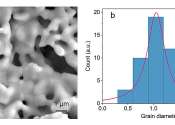A ceramic is an inorganic, nonmetallic solid prepared by the action of heat and subsequent cooling. Ceramic materials may have a crystalline or partly crystalline structure, or may be amorphous (e.g., a glass). Because most common ceramics are crystalline, the definition of ceramic is often restricted to inorganic crystalline materials, as opposed to the noncrystalline glasses.
The earliest ceramics were pottery[citation needed] objects or 27000 year old figurines made from clay, either by itself or mixed with other materials, hardened in fire. Later ceramics were glazed and fired to create a colored, smooth surface. Ceramics now include domestic, industrial and building products and art objects. In the 20th century, new ceramic materials were developed for use in advanced ceramic engineering; for example, in semiconductors.
The word "ceramic" comes from the Greek word κεραμικός (keramikos), "of pottery" or "for pottery", from κέραμος (keramos), "potter's clay, tile, pottery". The earliest mention on the root "ceram-" is the Mycenaean Greek ke-ra-me-we, "workers of ceramics", written in Linear b syllabic script. "Ceramic" may be used as an adjective describing a material, product or process; or as a singular noun, or, more commonly, as a plural noun, "ceramics".









